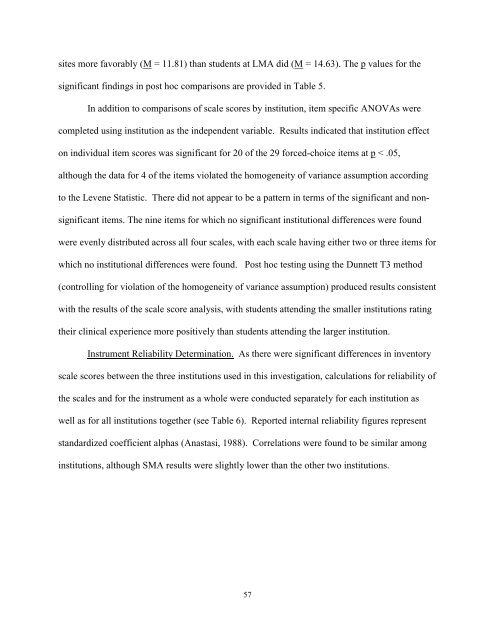STUDENT EVALUATION OF CLINICAL EDUCATION ENVIRONMENT
STUDENT EVALUATION OF CLINICAL EDUCATION ENVIRONMENT
STUDENT EVALUATION OF CLINICAL EDUCATION ENVIRONMENT
You also want an ePaper? Increase the reach of your titles
YUMPU automatically turns print PDFs into web optimized ePapers that Google loves.
sites more favorably (M = 11.81) than students at LMA did (M = 14.63). The p values for the<br />
significant findings in post hoc comparisons are provided in Table 5.<br />
In addition to comparisons of scale scores by institution, item specific ANOVAs were<br />
completed using institution as the independent variable. Results indicated that institution effect<br />
on individual item scores was significant for 20 of the 29 forced-choice items at p < .05,<br />
although the data for 4 of the items violated the homogeneity of variance assumption according<br />
to the Levene Statistic. There did not appear to be a pattern in terms of the significant and non-<br />
significant items. The nine items for which no significant institutional differences were found<br />
were evenly distributed across all four scales, with each scale having either two or three items for<br />
which no institutional differences were found. Post hoc testing using the Dunnett T3 method<br />
(controlling for violation of the homogeneity of variance assumption) produced results consistent<br />
with the results of the scale score analysis, with students attending the smaller institutions rating<br />
their clinical experience more positively than students attending the larger institution.<br />
Instrument Reliability Determination. As there were significant differences in inventory<br />
scale scores between the three institutions used in this investigation, calculations for reliability of<br />
the scales and for the instrument as a whole were conducted separately for each institution as<br />
well as for all institutions together (see Table 6). Reported internal reliability figures represent<br />
standardized coefficient alphas (Anastasi, 1988). Correlations were found to be similar among<br />
institutions, although SMA results were slightly lower than the other two institutions.<br />
57












